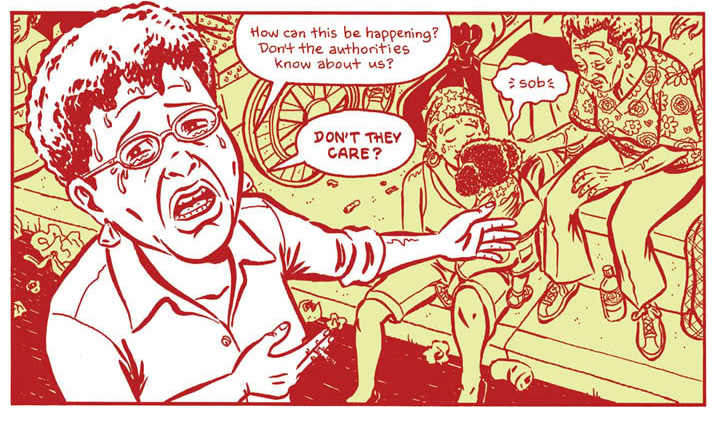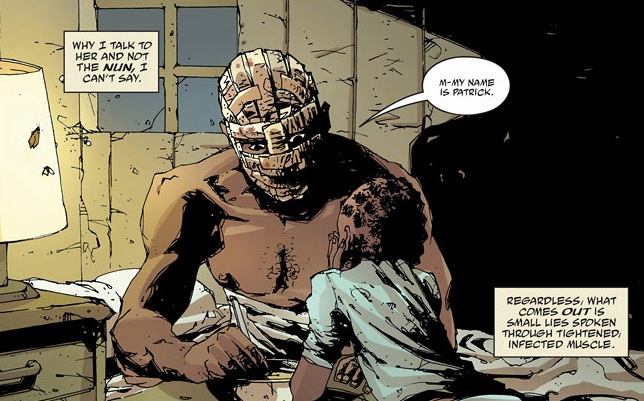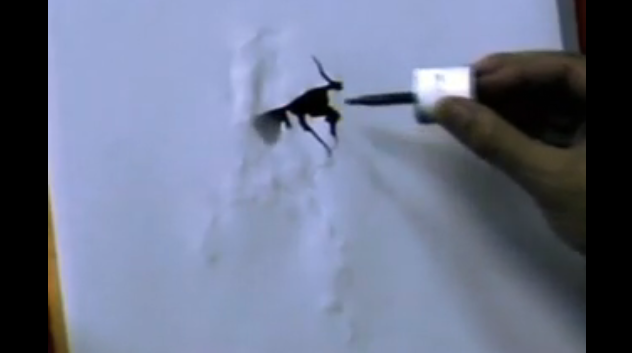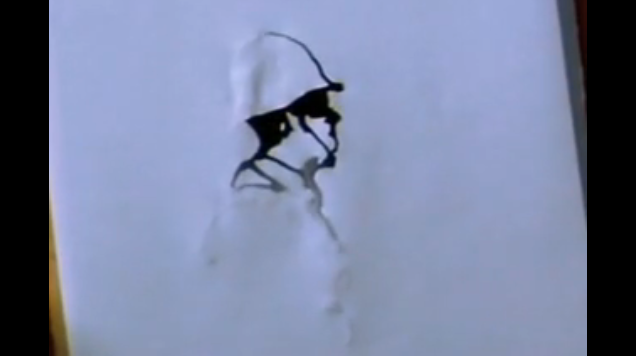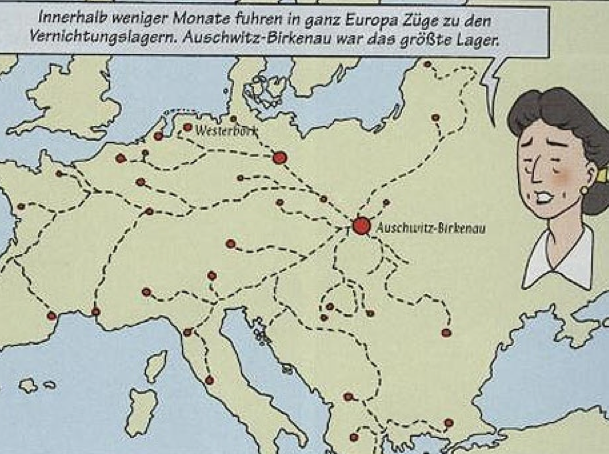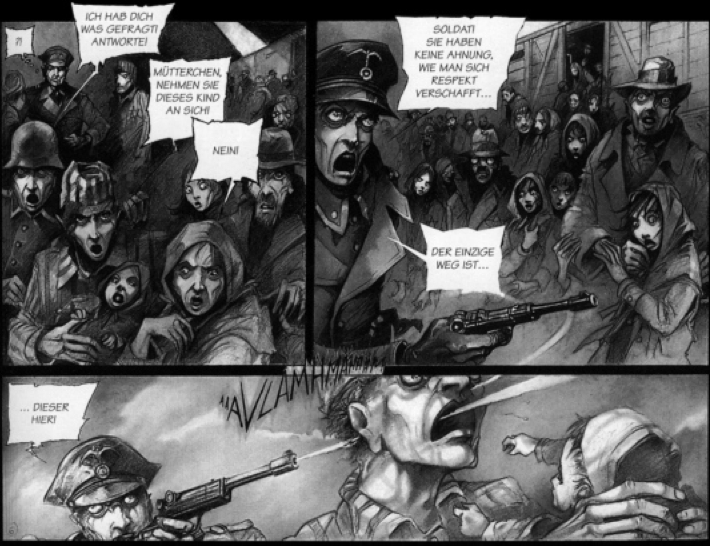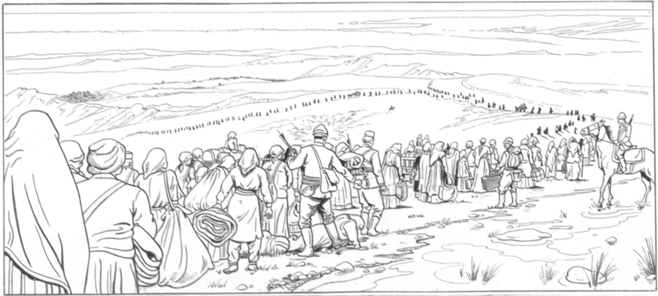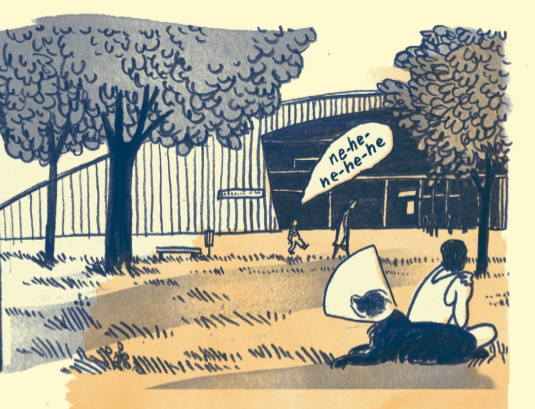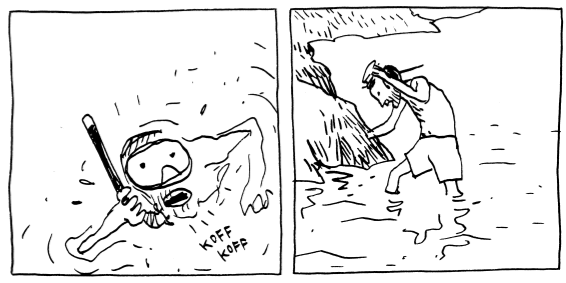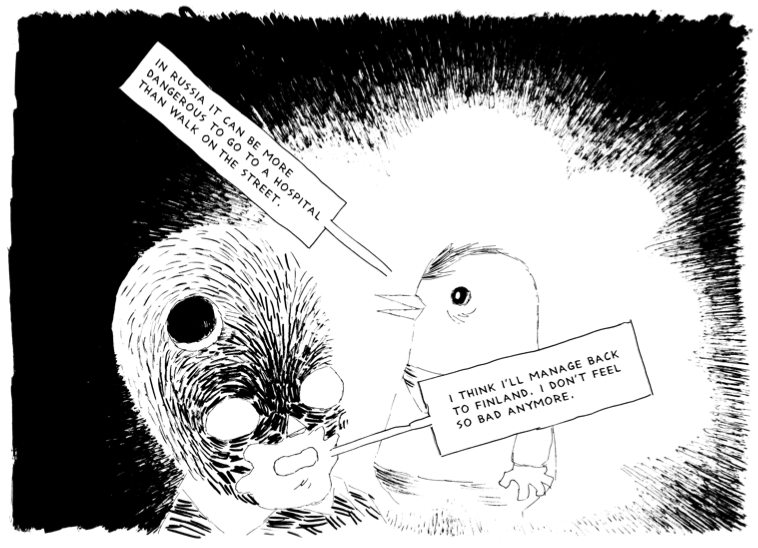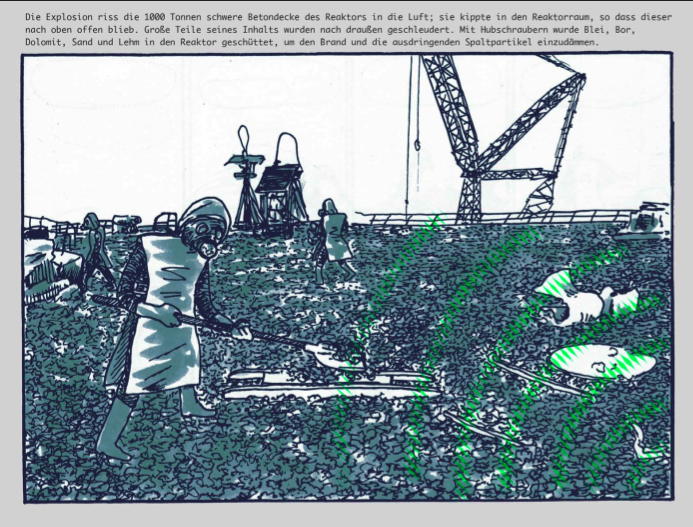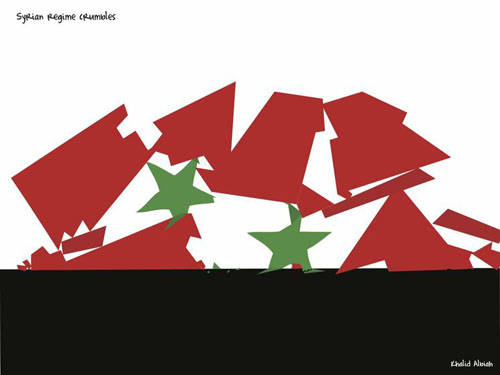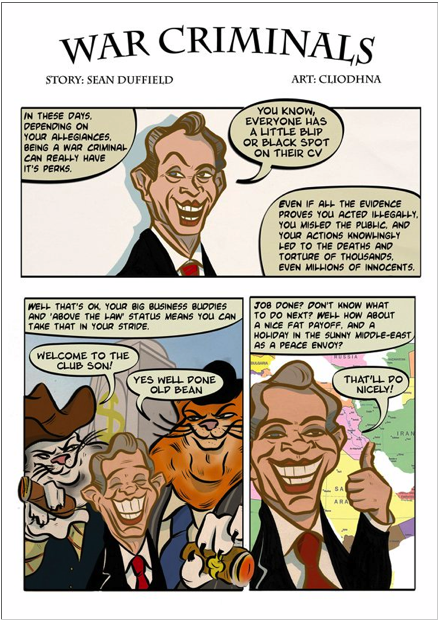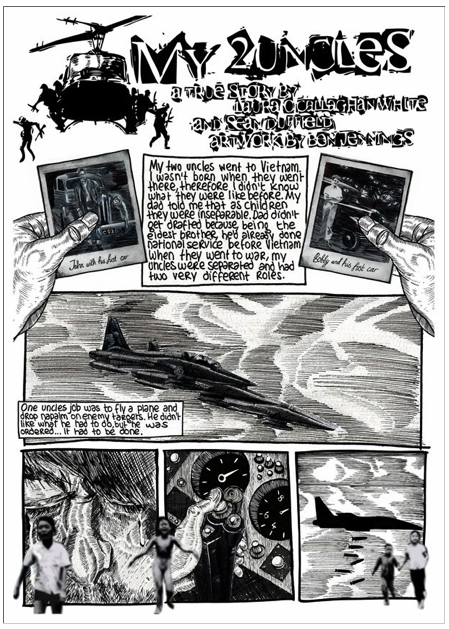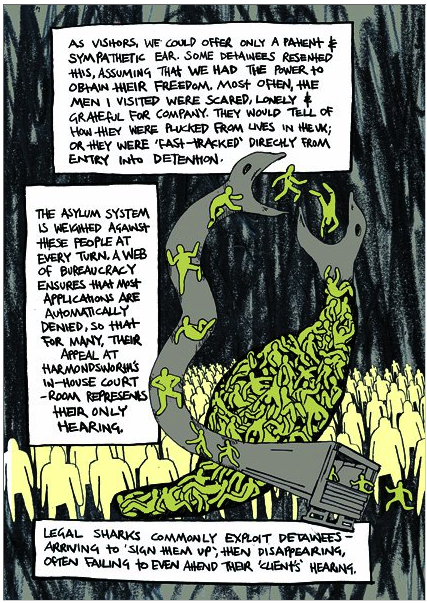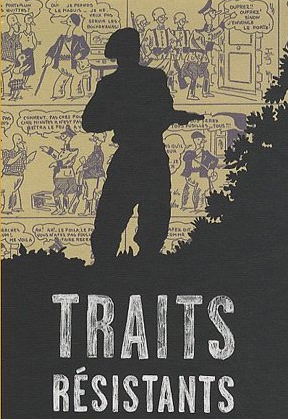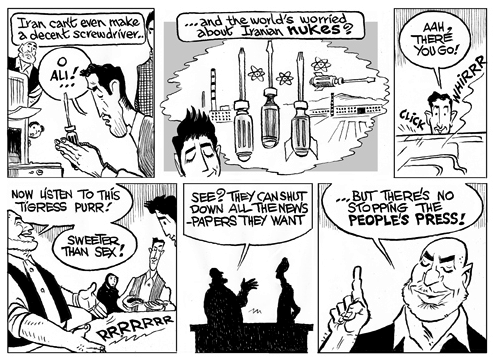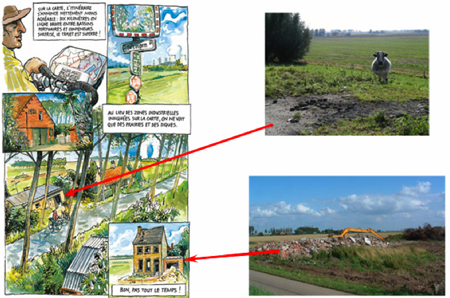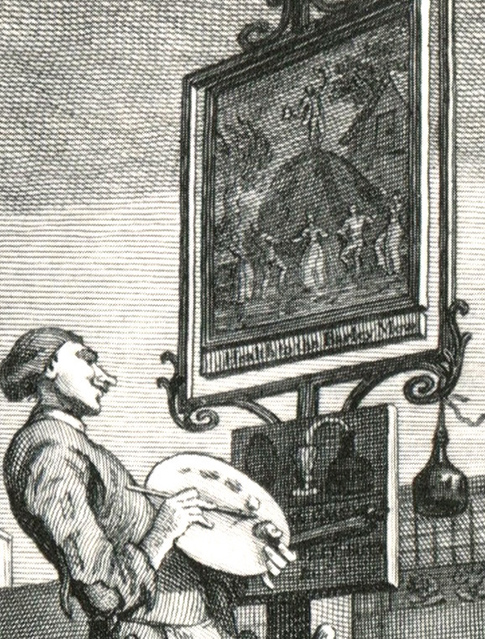[January 27, 2012
Comics as reports, a selection # 1 (MePri-News 4/9/09 – 25/1/12)
Nicht übersetzt:
4.9.2009
Josh Neufeld´s Hurricane Katrina Report
Josh Neufeld is known as a long-time contributor to Harvey Pekar’s autobiographical “real life” series American Splendor. In his graphic novel A.D.: New Orleans After the Deluge he tells the story of hurricane Katrina and its aftermath „from the perspective of real people still dealing with the storm each and every day.”
Neufeld further describes his work: “A two-part prologue sets the scene and shows the storm. In chapter one, I introduce A.D.’s characters, who include a sixth-generation New Orleanian with a Master’s Degree in counseling; a medical man-about-town based in the French Quarter; an Iranian-born owner of a family-run supermarket; the teenage son of a pastor from New Orleans East; and a twenty-something music ‘zine publisher and his girlfriend. The complete A.D. webcomic — the 2-part prologue, 13 chapters, and an epilogue — is hosted on the SMITH Magazine website, which also features audio & video interviews with the real subjects, a Hurricane Katrina resource list, and an active blog. We also do something pretty unique in the webcomic, which is provide links throughout the comic to podcasts, YouTube videos, archived hurricane tracking reports, and even personal details like The Doctor’s favorite mixed drink recipes. So as you’re paging through the story and you see a link, you can follow it to find out more about the character or event I’m portraying. It’s like ‘American Splendor 2.0’!Before Katrina, I had very little personal connection to New Orleans, other than the fact that my wife and I had visited the city for about a week in 2003. Then, when the hurricane hit, I was so affected by the tragedy that I volunteered with the Red Cross.” (Josh Neufeld, 29-1-09)
Besides his own experiences as a Red Cross volunteer, Neufeld draws upon interviews with the actual people represented in the story as well as upon newspaper and blog accounts of the events.
An extended hardcover version of his Katrina Report is published by Pantheon Graphic Novels.
Josh Neufeld: A.D.: New Orleans After the Deluge
——————————————————————–
12.8.2009
Civil War in Uganda: Dr. Lwanga Moses as the Unknown Soldier
Not many monthly comic books come with a glossary, but not many comics are like Unknown Soldier. The series, written by Joshua Dysart and illustrated by Alberto Ponticelli, is set in Uganda and includes a reference guide with more than 20 entries, including background on the brutal rebel group the Lord’s Resistance Army; the peace activist Abdulkadir Yahya Ali, who was killed; and the Acholi, an ethnic group from the northern part of the country.
Unknown Soldier, published by Vertigo, an imprint of DC Comics, is about Dr. Lwanga Moses, a Ugandan whose family fled the country for the United States when he was 7. He returns as an adult in 2002 with his wife, Sera, also a physician, hoping to put their medical skills to use in a part of the country that has experienced civil war for 15 years. He finds a world filled with violence, boys used as soldiers and girls punished for innocent acts like riding bicycles.
This hardly seems like the stuff of traditional comic books, but Unknown Soldier is a regular series; a collected edition, which reprints the first six issues, will be in bookstores beginning on Aug. 26. Dr. Moses, the title character, whose face is wrapped in bandages, is actually a reimagining of a DC protagonist from 1966 who was disfigured during World War II, wrapped in heavy bandages and sent on espionage missions.
Read the full article by George Gene Gustines in the New York Times
Dr. Lwanga Moses as a DC – Superheroe (Vertigo / DC)
——————————————————————–
28.11.2009
Visualizing Memory in a Second
It only takes one second to follow the way in which cartoonist Emmanuel Guibert managed to visualize the vaporous nature of memory in his graphic documentary on the reminiscences of former GI Alan Cope, who served in Europe during World War II.
——————————————————————–
20.7.2011
Holocaust im Comic
Das Bayern Forum der Friedrich-Ebert-Stiftung in München zeigt vom 19. Juli bis 19. August 2011 die Wanderausstellung „Holocaust im Comic.“ Eine steigende Zahl von graphic novels beschäftigt sich heute mit der NS-Zeit, manchmal zur mit aufklärerischen Absichten, manchmal zur martialischen Unterhaltung. Doch auch die Nazis selbst setzten das Medium für ihre antisemitischen Propaganda ein. Die Ausstellung zeigt, wie Rechtsextremismus, Antisemitismus und der Holocaust zu ganz unterschiedlichen Zwecken in Comics thematisiert wurden und werden. Kuratiert wird die Ausstellung von dem Comiczeichner und Kommunikationswissenschaftler Ralf Palandt
Aus: “Die Suche” von Eric Heuvel, hrsg. Anne Frank Zentrum
Aus: “Auschwitz” von Pascal Croci (Ehapa, Köln 2005)
——————————————————————–
9.1.2011
Graphic Genocides and Suicide Bombers
The first of two projected volumes of Cahier à fleurs, a graphic novel about the Armenian Genocide had appeard in April last year in Hachette´s collection Grand Angle. Vol.2 is announced for March this year. The plot centers on a Turkish violinist´s reminiscences of the massacers on the Armenian minorities in 1915. The graphics were executed by the Belgian comicstrip artist Viviane Nicaise and are based on the materials of the illustrated press.
Excerpt from: Cahier à fleurs (Galandon/Nicaise 2010)
Scenarist Laurent Galandon has appropriate practice in drafting catchy documentaries of thrilling matters. In his endeavour to tune into the success of Jacques Tardi´s historical graphic novels he wrote scenarios dealing with the Shoah L’envolée sauvage and the French Algerian War Tahya El-Djazaïr. In collabration with Frédéric Volante he is currently preparing a second volume of Shahidas, a story about islamic suicide bombers. There’s no question, the graphic documentary wave keeps rolling on.
Graphic Genocides…………………………………….
………………………………… and Suicide Bombers
——————————————————————–
28.1.2010
More Electrocomics
Since its foundation in 2005 electrocomics provides an inspiring mix of experimental strips and it´s always worthwile to check out the latest updates.
Go! Keep going! a very intense perceptive strip by Ulli Lust, the founder of electrocomics. A first draft of her prize winning Today is the last day of the rest of your life is here also published as a sequel
Rubiah, a series of sketchy impressions from holidays in Indonesia by Sacha Goerg.
Alien in Russia by Marko Turune, a strange and disturbing graphic short story that was originally published in the Finnish serial “Ufoja Lahdessa”
15.3.2011
Kai Pfeiffer´s Chernobyl – Report
Because of current events here a further reference to Kai Pfeiffer´s excellently researched comicstrip essay Radioactive forever.� It is provided as an e-book for free download, to read on the screen.
Kai Pfeiffer: Radioaktiv forever – ein comic essay
——————————————————————–
20.4.2011
Cartoon Movement
The Cartoon Movement is a community of international editorial cartoonists and fans of political satire, which provides a website with continuously updated cartoons and graphic novels. The cartoon section is edited by the Dutch editorial cartoonist Tjeerd Royaard, the comics journalism – section by the American cartoonist Matt Bors. “We select cartoonists based on the quality of their work and their demonstrated ability to tackle political, societal, economical and environmental issues in a way that sheds a different light on the matter, makes you laugh or think, or both. Applying cartoonists should have a number of years experience in the field of editorial cartooning and their own distinct style.”
19 Apr 2011 Khalid Albaih: Syrian regime crumbles
13 Apr 2011 Sarah Glidden and the CLP: The Waiting Room
——————————————————————–
11.8.2011
Comics & Conflicts
Comics & Conflicts: is a two day event held at the Imperial War Museum in London, comprising of an academic conference on Friday 19 August and an activities day giving you the chance to meet comic artists on Saturday 20 August.
Comics & Conflicts Conference: A conference at the Imperial War Museum in London exploring the ways in which comics around the world represent and articulate the experience and impact of war and conflict. Topics to be covered include the impact of 9/11, the relationship between the image and reality of war. Established and up and coming comics artists are also participating. Speakers include Pat Mills, legendary creator of Charley’s War; multiple Eisner winner Garth Ennis discussing his Battlefields series; and Martin Barker and Roger Sabin who’ll be talking about the depiction of war in the Guardian’s comic strip Doonesbury.
Excerpt from: War – The Human Cost, Paper Tiger Comix, 2011
In Conversation With Pat Mills: Author Pat Mills has been a pioneer and major contributor to British comics since the 1970s. He co-created Battle Picture Weekly in 1975 and returned to the title in 1979 to write the ground-breaking serialised strip of Charley’s War. Pat will be talking about the creation of Charley’s War and the research that he and the late illustrator Joe Colquhoun undertook throughout the run of the comic.
David Collier: The Artist Goes (Back) To War: Celebrated Canadian artist David Collier was inspired to become a cartoonist by Robert Crumb, who published his first comic. He is the author and illustrator of Chimo, which depicts his decision to re-enlist in the Canadian army and go through basic training again at age 40. David has been creating since his first tenure in the army, when he drew strips and discovered his talent for the biathlon in which he has competed nationally. There will be a signing after this event.
Artists & Publishers Discussion 1: Trauma & Conflict: Danish artist Mikkel Sommer, writer and illustrator of Obsolete, hauntingly evoking the impact of war on two US soldiers about to return home, is joined by Adrian Searle, the publisher of Dougie’s War, and artist Dave Turbitt. Dougie’s War explores the PTS of a soldier returning to the UK from Afghanistan. There will be a signing after this event. Chair: Paul Gravett.
Excerpt from: War – The Human Cost, Paper Tiger Comix, 2011
David Collier: Comic-Making Masterclass: David Collier may very well be the only cartoonist to have had the unlikely experience of serving in the Canadian Army. At least, he says, “the pay was good.” His first comic strip was published in 1986 in the Robert Crumb-edited magazine Weirdo, and throughout the years, his work has appeared in numerous comic anthologies, including Drawn & Quarterly, The Comics Journal and Zero Zero. Here he shares some of his comic making expertise in a hands-on workshop.
Artists & Publishers Discussion 2: The Personal & The Political: Artist Francesca Cassavetti, has republished her mother’s wartime diary as a comic. Eileen Cassavetti will be joining her daughter on stage. They will also be joined by Sean Duffield, enterprising publisher of War: The Human Cost and contributing artists Dan Locke and Ben Naylor. There will be a signing after this event. Chair: Alex Fitch.
In Conversation With Garth Ennis: Belfast-born Garth Ennis has been a major contributor to British and American comic books since 1989 following the publication of his strip Troubled Souls about the conflict in 1980s Ireland. A rare opportunity to meet the author of Unknown Soldier, War Is Hell, Enemy Ace, War Stories and Battlefields. There will be a signing after this event.
Film & Discussion: Comics Go To War: This fascinating documentary directed by Mark Daniels looks at the work of artist who are either born into conflict, or engage with it as journalists. Artists whose work is discussed include Joe Sacco, author of two books about the Middle East (Palestine, Footsteps In Gaza) and several from the former Yugoslavia. Greg Cook documented his experiences in Iraq. Keiji Nakazawa was a young boy when an atomic bomb was dropped on Hiroshima, an experience he depicts in his celebrated manga Hadashi no Gen (Barefoot Gen). Zeina Abirached’s comic Le Jeu des Hirondelles describes her childhood during the civil war in Lebanon. In her award-winning Persepolis Marjane Satrapi gives compelling insights into life in Iran before, during and after the Islamic Revolution.
Excerpt from: War – The Human Cost, Paper Tiger Comix, 2011
——————————————————————–
25.8.2011
La résistance dans la bande dessinée
Lyon is regarded as the centre of the French resistance against the German occupation. The Museum of Resistance and Deportation in Lyon shows an exhibition about the treatment of this historic subject in comic strips and graphic novels. The show TRAITS RÉSISTANTS. La résistance dans la bande dessinée de 1944 à nos jours , which runs until september 18, is accompanied by a comprehensive catalogue.
> PDF press release
——————————————————————–
18.9.2011
Zahra´s Paradise: Dissidence in Iran
After the huge success of the webversion, Zahra’s Paradise, the semi-documentary or real-time fictional graphic novel on the situation of political dissidents in Iran is finally published in English and German versions. It was created by two Iran authors in exile, which hide their identities under pen names to protect their families at home. Amir is an Iranian-American human rights activist, journalist and documentary filmmaker and Khalil a sculptor and cartoonist. “Set in the aftermath of Iran’s fraudulent elections of 2009, Zahra’s Paradise is the fictional story of the search for Mehdi, a young protestor who has disappeared in the Islamic Republic’s gulags. Mehdi has vanished in an extrajudicial twilight zone where habeas corpus is suspended. What stops his memory from being obliterated is not the law. It is the grit and guts of a mother who refuses to surrender her son to fate and the tenacity of a brother—a blogger—who fuses culture and technology to explore and explode absence: the void in which Mehdi has vanished.”
——————————————————————–
1.12.2011
Doel dies
The French magazine XXI recently published a graphic documentary by comic artist Jeroen Janssen about a picturesque Flemish village named Doel, located between the harbours and the nuclear reactor of Antwerp. Doel became famous for it´s staunch resistance against a future enlargement of the harbours in whose course it is facing complete demolition. Janssen records the proceeding conversion works and the struggle of the last inhabitants of the abandoned village. The graphic report is included in the autumn edition (nr. 16) of XXI.
Jeroen Janssen,Retour en Flandre, XXI 2011
——————————————————————–
25.1.2012
e-book
“Seeing Odessa” by Björn Dermann
Björn Dermann´s concise graphic travelogue is based on local researches during a stay in the Russian port city in May 2011.” The young people in Odessa look at this new world of consumption as reverently as their mothers looked at Lenin – even more reverently because their mothers had to look at him, whereas they don’t have to, not really. You look beyond, you do what you want to do, but definitely more wishing for anarchy than anywhere else. It seems as if the city is on its way to develop a unique post-communist self-confidence.”
The report is available for download on the commendable site electrocomics, one of the best and most varied sources for independent comics. Björn Dermann is also responsible for the comic-series Der Ökodiktator about the local goverment in Stuttgart, which he creates in collaboration with the journalist Peter Unfried. The series is published in the weekly journal Kontext.
